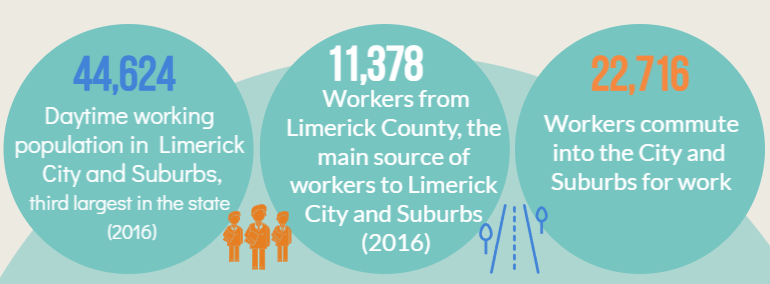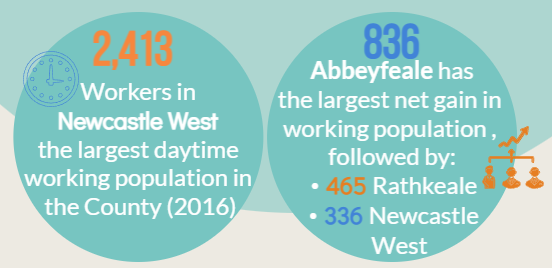2.10 Daytime Working Population
Commuting data from Census 2016 confirm that Limerick City is a major centre of employment, with over 22,700 workers commuting daily into the city and suburbs. This represents slightly more than the number of city residents where the location of their work is the city and suburbs. After Dublin and Cork, Limerick City and Suburbs overtook Galway as the State's third largest daytime working population in 2016.
Key Locations of Jobs
Limerick County (11,378) was the main source of workers to Limerick city and suburbs, followed by Clare (5,553) and Tipperary North (2,542). Annacotty was the main feeder town for Limerick city and suburbs (743), followed by Castleconnell (400), Ballina (355), Newport (318) and Ardnacrusha (302). This highlights the importance of Limerick City and Suburbs as a location of jobs.

Towns with Significant Numbers of Jobs
An analysis of the largest population towns in County Limerick shows that Abbeyfeale (836), Rathkeale (465) and Newcastle West (337) all have a significant net gain in their respective working populations (i.e., they have more daytime jobs in the towns compared with the number of residents of the town at work). Newcastle West, the largest town, has the largest daytime working population (2,413). However, Abbeyfeale shows the largest net gain in the working population (number of daytime jobs in Abbeyfeale) relative to the number of residents who are at work. Patrickswell, in contrast, shows a net loss in its working population (-78) with more people resident in Patrickswell at work compared with the number of daytime jobs in the village. The analysis of the daytime working populations of the larger settlements shows the economic importance of the larger rural market towns (Newcastle West, Abbeyfeale, Rathkeale and Kilmallock).

Commuting Patterns and Climate Action
Abbeyfeale has the largest proportion of residents who live and work within the settlement (51%) followed by Kilmallock (42%). Generally, the data show a pattern of cross-commuting to work and home. This highlights the scope for, and need to, create the economic opportunities, infrastructure and quality of life factors to allow and incentivise people to live and work within the same area.
The growth of populations along and close to main transport corridors in rural Limerick and the profile of higher incomes in these areas indicate that these areas are populated by persons in work. As much of this area is rural in character, these are likely car commuters. Revitalising areas based on compact growth, where people can live and work in the same place or commute shorter distances using active travel, is a national policy priority. This is important in order to decrease carbon emissions by reducing reliance on the car for day-to-day transport.